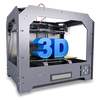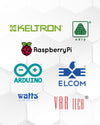
The Role of Connectors in High-Speed Data Transmission
As technology races forward, the demand for faster, more reliable communication between devices grows with it. Whether you’re streaming a 4K video, transmitting sensor data in real-time, or debugging a high-performance embedded system, data transmission speed is key. But one often-overlooked hero in this process is the connector.
While cables and chips usually steal the spotlight, connectors are the unsung champions enabling those high-speed transfers. In this blog, we’ll explore how connectors impact data transmission, why they matter more than ever, and how to choose the right one for your next high-speed electronics project.
Why Connectors Matter in High-Speed Systems
At low frequencies, almost any connector will do. But as speeds creep into the hundreds of megahertz and beyond, your connector isn’t just a piece of metal it becomes a critical part of your signal path.
High-speed digital signals behave more like analog waveforms, making them vulnerable to:
-
Signal reflections
-
Impedance mismatches
-
Crosstalk
-
Insertion loss and return loss
A poorly matched connector at high data rates can corrupt your signal, cause data loss, or increase error rates resulting in anything from slower file transfers to system crashes.
Understanding Signal Integrity
In high-speed communication, signal integrity refers to the ability of a signal to travel from sender to receiver without distortion. The connector plays a vital role in this by:
-
Maintaining consistent impedance
-
Reducing electromagnetic interference (EMI)
-
Minimizing insertion and return loss
-
Ensuring low contact resistance
Even minor discontinuities in your connection path like a misaligned or low-quality connector can introduce reflections or attenuation that distort digital waveforms.
Types of Connectors Used in High-Speed Data Transmission
Let’s break down a few commonly used connector types that support high-speed communication:
1. USB Connectors (Type-A, Type-C, Micro USB)
-
Speed: Up to 40 Gbps with USB4
-
Use case: Computers, mobile devices, embedded systems
-
Note: USB-C is preferred for high-speed and bi-directional communication due to better signal integrity and power delivery support.
2. HDMI Connectors
-
Speed: Up to 48 Gbps (HDMI 2.1)
-
Use case: Audio/video equipment, game consoles, monitors
-
Note: Requires high-quality cable and gold-plated connectors to ensure reliable high-bandwidth delivery.
3. SATA and M.2 Connectors
-
Speed: 6 Gbps (SATA III), up to 32 Gbps (PCIe 4.0 on M.2)
-
Use case: High-speed storage like SSDs
-
Note: Precision connectors with tight tolerances ensure error-free data transfers between the motherboard and storage devices.
4. RJ45 Ethernet Connectors
-
Speed: 1 Gbps (Cat 5e), 10 Gbps (Cat 6a/7)
-
Use case: Networking, IoT, industrial systems
-
Note: Shielded connectors help reduce EMI in noisy environments, especially for PoE (Power over Ethernet) setups.
5. FPC/FFC Connectors
-
Speed: Varies, supports high-speed parallel signals in compact designs
-
Use case: Embedded systems, displays, cameras
-
Note: These flat ribbon connectors are critical for space-saving designs like smartphones or drones.
6. Coaxial Connectors (SMA, BNC, MMCX)
-
Speed: Up to several GHz
-
Use case: RF, antennas, high-frequency testing
-
Note: Perfect impedance matching and shielding are essential to maintain signal clarity at high frequencies.
What to Consider When Choosing a High-Speed Connector
Choosing the right connector isn't just about the pin count. Here’s what matters most for high-speed projects:
1. Impedance Matching
-
Most high-speed lines are designed for 50Ω or 100Ω differential impedance.
-
Choose connectors that match the impedance of your trace or cable to avoid reflections and standing waves.
2. Insertion and Return Loss
-
Insertion loss: Signal attenuation as it passes through the connector.
-
Return loss: Power reflected back due to impedance mismatch.
-
Lower dB values for both indicate better high-speed performance.
3. Crosstalk and EMI Shielding
-
As frequencies increase, signals can interfere with each other.
-
Shielded connectors or twisted-pair layouts help minimize this.
4. Mechanical Durability
-
Look for a high mating cycle rating (>1000 insertions) for development boards and field-use devices.
-
Consider gold-plated contacts for better corrosion resistance.
5. Size and Layout
-
For compact designs (e.g., drones, wearables), space is a constraint.
-
FPC, micro coax, or board-to-board connectors are preferred for saving space without sacrificing speed.
Real-World Applications: Where Speed and Connection Meet
High-Speed Cameras
Cameras used in automation or machine vision use high-bandwidth connectors like USB 3.0 or CameraLink to handle real-time HD video without delay.
Automotive Systems
Modern vehicles use LVDS and Ethernet connectors to link cameras, radar, and infotainment systems requiring robust connectors that handle heat, vibration, and EMI.
Aerospace & Defense
In these environments, both data integrity and ruggedization are vital. MIL-spec connectors rated for GHz performance are standard.
Consumer Electronics
Your laptop’s USB-C or Thunderbolt port is doing a lot more than charging — it’s handling data, video, and power simultaneously through a high-precision connector.
Tips for Handling High-Speed Connectors
-
Avoid sharp bends or routing connectors near high-current lines to reduce noise.
-
Use proper mounting techniques to avoid physical stress or warping.
-
Always use ESD protection when handling sensitive connectors, especially coaxial or differential signal types.
-
When prototyping, invest in breakout boards for fine-pitch connectors it makes debugging much easier!
Recommended Tools for Connector Work
If you work with high-speed connectors regularly, consider having:
-
A good multimeter with continuity check
-
Magnifying lamp or microscope for inspecting fine pins
-
Impedance analyzer or TDR (for advanced debugging)
-
Proper crimping tools and wire strippers for custom connectors
-
Antistatic mat and wrist strap to avoid ESD damage
Final Thoughts: Connectors Are the Unsung Heroes
It’s easy to think of connectors as just physical hardware something to plug and unplug but in high-speed data systems, they’re an integral part of the signal chain. A poor-quality or mismatched connector can bring your entire design to a halt.
Whether you're wiring up a home automation controller, setting up a high-speed sensor array, or building a prototype for your next big startup idea choosing the right connector can make or break your performance.
So the next time you design a circuit or pick up a development board, pay close attention to the connectors. They might just be the most important component in your build.



